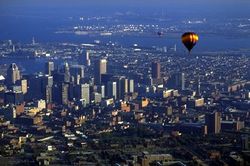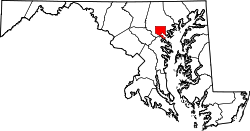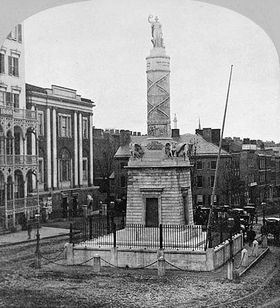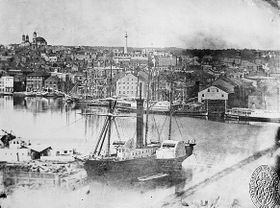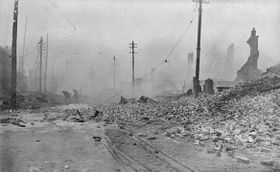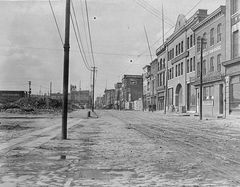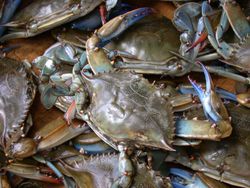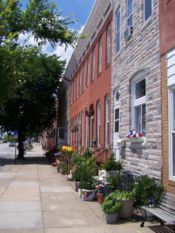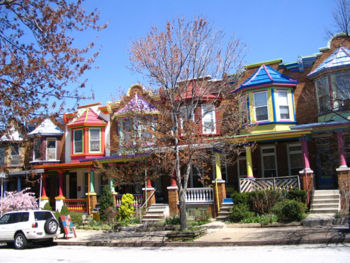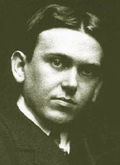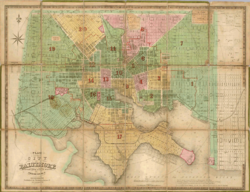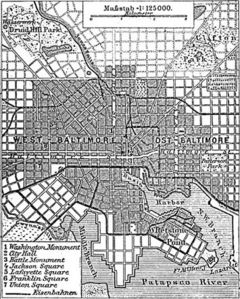Baltimore, Maryland
2007 Schools Wikipedia Selection. Related subjects: North American Geography
| Baltimore, Maryland | |||||
| A view of the Baltimore skyline from above. | |||||
|
|||||
| Nickname: "Monument City", "Charm City", "Mob Town", "B-more", "Balmerr''" | |||||
| Motto: "The Greatest City in America" (formerly "The City That Reads"; "Get In On It" is not the city's motto, but rather the advertising slogan of the Baltimore Area Convention and Visitors Association"; BELIEVE" is not the official motto but rather a specific campaign) | |||||
| Location of Baltimore in Maryland | |||||
| Coordinates: | |||||
|---|---|---|---|---|---|
| Country | United States | ||||
| State | Maryland | ||||
| County | Independent City | ||||
| Founded | 1729 | ||||
| Incorporated | 1797 | ||||
| Mayor | Martin J. O'Malley ( D) | ||||
| Area | |||||
| - City | 238.5 km² (92.1 sq mi) | ||||
| - Land | 209.3 km² (80.8 sq mi) | ||||
| - Water | 29.2 km² (11.3 sq mi) | ||||
| Elevation | 10 m (33 ft) | ||||
| Population | |||||
| - City (2005) | 641,943 | ||||
| - Density | 3,039/km² | ||||
| - Urban | 2,178,000 | ||||
| - Metro | 2,639,213 | ||||
| Time zone | EST ( UTC-5) | ||||
| - Summer ( DST) | EDT ( UTC-4) | ||||
| Website: www.baltimorecity.gov | |||||
Baltimore is an independent city located in the U.S. state of Maryland on the eastern coast of the United States of America. As of 2005, the population of Baltimore City was 641,943 and the Baltimore-Towson metropolitan area has approximately 2.6 million residents . Baltimore is the largest city in Maryland and serves as the state's major cultural and industrial centre.
The city is named after the founding proprietor of the Maryland Colony, Lord Baltimore in the Irish House of Lords. Baltimore became the second leading port of entry for immigrants to the United States during the 1800s. The city is a major U.S. seaport, situated closer to major midwestern markets than any other major seaport on the East Coast.
Because there is also a Baltimore County surrounding (but not including) the city, it is sometimes referred to as Baltimore City when a clear distinction is desired.
People from Baltimore are known as "Baltimoreans."
History
During the 17th century, various towns called "Baltimore" were founded as commercial ports at various locations on the upper Chesapeake Bay. The present city dates from July 30, 1729, and is named after Lord Baltimore, who was the first Proprietary Governor of the Province of Maryland. Baltimore grew swiftly in the mid- to late 18th century as the granary for sugar-producing colonies in the Caribbean. The profit from sugar encouraged the maximum possible cultivation of cane and the importation of food. The relatively shorter distance between Baltimore and the Caribbean colonies allowed swift transport and minimized the spoilage of flour.
One of Baltimore's greatest moments occurred during the War of 1812 with the British, who had declared Baltimore "A nest of Pirates." Baltimore's Fort McHenry came under attack by British forces near the harbour after the British had burned Washington, D.C. Known today as the Battle of Baltimore, American forces won the decisive battles by repulsing a joint land and naval attack by the British forces. They fought to a stalemate at the Battle of North Point after killing the British commander General Ross. British reinforcements were not possible after the British Navy was repulsed by the defenders of the fort, and all forces then withdrew. It was the naval engagement that inspired Francis Scott Key to write the poem " The Star-Spangled Banner," the lyrics to the United States' national anthem. The battle was memorialized in the Battle Monument which is on the city seal.
On an 1827 visit to the city John Quincy Adams nicknamed it "Monument City."
Baltimore is also the site of the first architectural monument honoring George Washington, a 178-foot Doric column erected in 1829 and designed by Robert Mills, who later designed the Washington Monument in Washington, D.C.
Baltimore became an independent city in 1851, being detached from Baltimore County at that time.
Prior to the Civil War, Maryland was a slave-holding state. During the Civil War, Maryland was officially part of the Union, but kept slavery legal. Pro-Southern sentiment led to the Baltimore riot of 1861, when Union soldiers marched through the city. After the riot, Union troops occupied Baltimore, and Maryland came under direct federal administration — in part, to prevent the state from seceding — until the end of the war in April 1865. This was considered a necessary move by the Union to prevent Washington, D.C., from being completely surrounded by seceded Confederate territory. The case Ex parte Merryman, written by Supreme Court Chief Justice Roger Taney (himself a Marylander), dealt with the habeas corpus rights of Marylanders jailed by the Abraham Lincoln Administration and strongly rebuked Lincoln for his actions.
The Great Baltimore Fire on February 7, 1904, destroyed over 1,500 buildings in 30 hours and forced most of the city to rebuild. Immediately afterward, Mayor Robert McLane was quoted in the Baltimore News as saying, "To suppose that the spirit of our people will not rise to the occasion is to suppose that our people are not genuine Americans. We shall make the fire of 1904 a landmark not of decline but of progress." He then refused assistance, stating "As head of this municipality, I cannot help but feel gratified by the sympathy and the offers of practical assistance which have been tendered to us. To them I have in general terms replied, 'Baltimore will take care of its own, thank you.'" (McLane committed suicide on May 30.) Two years later, on September 10, 1906, the Baltimore-American reported that the city had risen from the ashes and "one of the great disasters of modern time had been converted into a blessing."
Baltimore is the location of the Baltimore World Trade Centre, the world's tallest equilateral five-sided building (the five-sided JPMorganChase Tower in Houston, Texas is taller but has unequal sides).
Baltimore is also the location of Pimlico Race Course, the home of the Preakness Stakes, the second leg of the Triple Crown of Thoroughbred Racing. The Preakness has been run since 1873.
Baltimore's population peaked at 949,708 in the 1950 Census, which ranked it as the sixth-largest city in the country, behind Detroit, and ahead of Cleveland. For the next five decades, the city's population declined while its suburbs grew dramatically, bottoming out in 2000 at 636,251. In the 21st century, the city's population has stabilized and is once again rising, mostly due to revitalization efforts in many city neighborhoods.
In 1955 Flag House Courts, a public housing project made up of 3 12-story buildings, was built. The buildings were eventually demolished in 2001.
In recent years, efforts to redevelop the downtown area have led to a revitalization of the Inner Harbour. In 1979 the Baltimore Convention Centre was opened and was subsequently renovated and expanded in 1996. Harborplace, a modern urban retail and restaurant complex, was opened on the waterfront in 1980, followed by the National Aquarium in Baltimore, Maryland's largest tourist destination, and another cultural venue, the Baltimore Museum of Industry in 1981. In 1992, the Baltimore Orioles of Major League Baseball moved from Memorial Stadium to Oriole Park at Camden Yards downtown, and six years later the Baltimore Ravens of the National Football League moved next door into PSINet Stadium (later renamed M&T Bank Stadium following PSINet's bankruptcy).
On October 2, 1996, Baltimore became the first city in the United States to adopt 311 as a non-emergency "hot line" telephone number, in order to reserve the use of 911 for genuine emergencies. The concept has been highly successful, and numerous other American municipalities have since implemented the practice.
A 60-car train derailment occurred in a tunnel in Baltimore on July 18, 2001. The derailment sparked a chemical fire that raged for six days and virtually shut down the downtown area until the heat caused a water main to rupture, largely extinguishing the fire but also causing significant flooding in the streets above. Three weeks later, manhole covers flew into the air as underground explosions along West Pratt Street followed due to residual explosive chemicals from the fire left in the sewers.
In 2003, the Baltimore Development Corporation announced that three hotel projects were being reviewed. As of September 2006, the 756-room, $305 million Hilton hotel project is currently under construction west of the Baltimore Convention Centre. The City of Baltimore hopes to have it finished and opened by August 2008. (See Baltimore Convention Centre Hotel Project for more details regarding the convention centre hotel.)
Also in 2003, Baltimore was affected by Hurricane Isabel from flooding as a result of tidal surge, affecting primarily the Fells Point community and the Inner Harbour and surrounding low areas. Many places were flooded, including the sports centre ESPN Zone, the Baltimore World Trade Centre (which remained closed for approximately a month during cleanup efforts), and most of the Inner Harbour. Water levels rose some 20 feet in areas, flooding underground parking garages and displacing thousands of cubic yards of trash and debris.
Beginning in the early part of the 21st century, Baltimore has undergone a major building spree in the downtown area, specifically in the Inner Harbour East district. The skyline has extended further outward and upward,and will continue to do so well into the next decade. ARC Wheeler, a Philadelphia-based developer has been approved to build a new hotel/condominium complex that will be the city's new tallest building, dubbed " 10 Inner Harbour," initially approved at 59 stories and 717ft tall, but rumored to be in the process of being redesigned to be even taller. Other proposals for downtown skyscrapers are twin 65-story towers at sites on E. Saratoga Street and Guilford Avenue, an 800ft.+ tower and complex located on the banks of the Patapsco River's middle branch area, and a 40-story condo and hotel tower at 300 E. Pratt Street.
Law and government
Baltimore is an independent city — not part of any county. For most governmental purposes under Maryland law, Baltimore City is treated as a "county"-level entity. The United States Census Bureau uses counties as the basic unit for presentation of statistical information in the United States, and treats Baltimore as a county equivalent for those purposes.
Baltimore has been a Democratic stronghold for over 150 years, with Democrats dominating every level of government.
Mayor
In November of 2006, Mayor Martin O'Malley won the Maryland gubernatorial election and will become Governor in January of 2007. At that time, Sheila Dixon, president of the Baltimore city council, will become mayor and serve out the remaining year of O'Malley's term, becoming the city's first female mayor. Dixon says that she intends to run for a full term in the 2007 election, but many other prominent city political figures are also interested in entering the race .
Baltimore City Council
Grassroots pressure for reform, voiced as Question P, restructured the city council in November of 2002, against the will of the mayor, the council president, and the majority of the council. A coalition of union and community groups, organized by ACORN, backed the effort.
The Baltimore city council is now made up of 14 single member districts and one elected at-large council president. Sheila Dixon is the current council president. On November 2, 2004, Dixon won re-election in a two-way contest; Joan Floyd, a Green Party candidate, was the only challenger; the Republicans did not field a candidate.
State Government
Baltimore and its suburbs were long underrepresented in the Maryland General Assembly, while rural areas were heavily overrepresented. Since Baker v. Carr in 1969, the Baltimore suburbs account for a substantial majority of seats in the state legislature.
Baltimore dominated Maryland state politics prior to 1969, however; even today, most of the states' highest elected officials come from the Baltimore area.
Federal Government
There are no Congressional congressional districts that lie entirely inside Baltimore. Three lie partly in the city — the 2nd, represented by Dutch Ruppersberger; the 3rd, represented by Ben Cardin; and the 7th, represented by Elijah Cummings. All three are Democrats; a Republican has not represented a significant portion of Baltimore in decades, and has not represented any of Baltimore since 2002.
Both of Maryland's Senators, Paul Sarbanes and Barbara Mikulski, are from Baltimore. Sarbanes is retiring at the end of the current Congressional session and will be succeeded by Cardin. Cardin's former seat in the House of Representatives was won by John Sarbanes, the son of the retiring Senator.
Crime
City Crime Rankings (12th Edition) ranks Baltimore second only to Detroit among the most dangerous American cities over 500,000 in population. According to crime statistics there were 269 murders in Baltimore in 2005, giving it the highest murder rate per 100,000 of all U.S. cities of 250,000 or more population. Though this is significantly lower than the record-high 353 murders in 1993, the murder rate in Baltimore is nearly seven times the national rate, six times the rate of New York City, and three times the rate of Los Angeles. In addition, other categories of crime in Baltimore have also been declining, although overall crime rates are still high compared to the national average. The rate of forcible rapes has fallen below the national average in recent years; however, Baltimore still has much higher-than-average rates of aggravated assault, burglary, robbery, and theft and a local news survey, though unscientific, recorded that over 75% of respondents felt that Baltimore City is no safer.
Though the crime situation in Baltimore is considered one of the worst in the nation, city officials have pointed out that most violent crimes, particularly murders, are committed by people who know their victims and who are often associated with the illegal drug trade.
City officials have, however, come under scrutiny from Maryland legislators regarding the veracity of crime statistics reported by the Baltimore City Police Department. For 2003 the FBI identified irregularities in the number of rapes reported, which was confirmed by the Mayor. 2005's murder numbers appear to exhibit discrepancies as well The former Commissioner of Police states upon interview that the administration suppressed corrections of its reported crime. However, many of these charges seem to be, at least partially, politically motivated. Nonetheless, experts indicate that the city's reporting practices should raise eyebrows and call for an independent audit, with which the administration has not cooperated, despite requests from members of City Council and the City's auditor. While racial disparities in arrest and incarceration rates exist in Baltimore, both young white and black men in the city are arrested and incarcerated at relatively high rates. Fifty-two percent of black males in their 20s are either in prison, in jail, or under correctional supervision. Of the roughly 100,000 arrests each year in this city of 635,000, about a quarter do not merit charging and another quarter do not merit prosecution. The ACLU has filed a suit in respect of systematic civil rights abuses by the current administration.
Criminal intimidation has also been reported as a problem in the city. In an infamous case, community activist Angela Dawson and her family were murdered by firebomb in their Baltimore home on October 16, 2002, in retaliation for Dawson's reporting of criminal activity. In a separate incident, another public safety activist, Edna McAbier, was also targeted. Though she survived, she has fled her neighbourhood, where she cannot be protected by city police. In 2005, 3 men were sentenced to life in prison for their involvement in the latter case. One of these men had appeared in the infamous video Stop Snitchin', a homemade DVD produced by local drug dealers threatening fellow dealers who failed to adhere to a street based code of ethics and became informants.
Culture
The city's geography and history as a working class port town has given it a very distinctive social flavor. The most prominent example is the city's association with blue crabs. The Chesapeake Bay for years was the East Coast's main source of blue crabs, and Baltimore became the central hub of the crab industry. In the tourist district (between Harborplace and Fells Point), it is almost impossible to find a shop or restaurant that does not serve crabs or crabcakes, or sell some sort of crab related merchandise. Maryland's distinctive way of eating crabs is often not understood by outsiders. Traditionally, crabs are steamed in rock salt and Old Bay Seasoning, a favored local all-spice manufactured in Baltimore for decades. They are eaten on tables spread with newspaper with the use of only a wooden mallet, a knife, and one's hands. Cold beer is also said to be a must.
Another popular Baltimore food item is the "chicken box". A chicken box is an inexpensive meal consisting of 4 or 5 fried chicken pieces served in a fast food carry out box with some kind of starch as a side (e.g. mashed potatoes, fries, rice, but usually biscuits). The item is chiefly sold at independent fried chicken shops and delis in the city. Chicken boxes are usually enjoyed with "Half and Half", a drink combining iced tea and lemonade — referred to elsewhere in the U.S. as an " Arnold Palmer".
Baltimore Club Music
Baltimore Club or Baltimore House is a recent musical movement that started in the late eighties in the clubs of Baltimore City. The earliest masters of this style were DJ Technics, the Dew Doo Kids, and Rod Lee, it is a fast pace style combining hip hop, house, and techno music together. The songs will sample hooks and repeat them over beats going as fast as 140 beats per minute. It has gained enough popularity to spring artist like D.O.G., the Bossman, and Young Leek to major deals with Universal, So So Def, and Roc-a-fella. The recent stars of this music movement are DJ K Swift and DJ Blackstarr. Though club music is a DJ led movement, recently Rap stars have taken over the scene and created a new sub-genre of rap, the stars are the aforementioned D.O.G. and Young Leek, also A-MAZ-ON, Tae Eazy, Deuce Tre Deuce, Prince, and Penny X. This movement has become so huge that it has been recognized by MTV as the next big movement and has been hailed as Next Up by Vibe.
Natty Boh
The city's favored local beer has traditionally been National Bohemian, or, as residents refer to it, Natty Boh. In some areas of Baltimore, locals call it "National." The beer and its one time mascot, Mr. Boh, are considered indelible parts of Baltimore culture. Though it is said that few truly enjoy the drink, the historically low price and association with the city make it a local favorite. The National Brewing Company was also the "inventor" of Colt 45 malt liquor in 1963. Natty Boh was also the long-time beer of choice for Orioles and Colts fans at Memorial Stadium. After the Orioles moved from Memorial Stadium in 1991, Natty Boh was no longer available to fans at Baltimore sporting events. However, for the 2006 Orioles season, "Boh is Back" and is being served throughout Oriole Park.
The Block
Residents are often proud of Baltimore's old-fashioned and often seedy characteristics. One of the more famous seedy spots in the city is The Block, a stretch of district along Baltimore Street between South Street and Gay Street. Since the late 19th century, the location has variously been home to burlesque shows, nightclubs, strip clubs, pornography shops, and prostitution.
Though the presence of BPD Headquarters at one end of the district has cut down on many illegal activities, the adult entertainment has continued and the area is still popular for city nightlife.
Rowhouses
Baltimore is noted for its near-omnipresent rowhouses. Rowhouses have been a feature of Baltimore architecture since the 1790s, with early examples of the style still standing in the Federal Hill and Fells Point neighborhoods. Older houses may retain some of their original features, such as marble doorsteps, widely considered to be Baltimore icons in themselves. Later rowhouses dating from the 1800s-1900s can be found in Union Square and throughout the city in various states of repair. They are a popular renovation property in neighborhoods that are undergoing urban renewal, although the practice is viewed warily by some as a harbinger of " yuppification." Elsewhere in the city, rowhouses can be found abandoned, boarded-up, and reflective of Baltimore's inner-city blight.
Marble Steps
Marble steps found along the streets of Baltimore are as much a part of the city's culture as crabs and baseball games. The use of marble for steps is due to the presence of high quality white marble in Cockeysville, a town 17 miles north of Baltimore harbour by highway. Indeed, the marble found there is so attractive, stone was hauled all the way from this northern Maryland town to the nation’s new capital, instead of local Potomac marble quarries, for use in decorative construction around Washington, D.C., including the Washington Monument, and 108 columns of the capitol building. During the construction phase of the Washington Monument, that is through the middle of the 19th century, the marble gained in popularity as a decorative stone and was used omnipresently for the steps of rowhouses surrounding Baltimore harbour and in Fells Point. Baltimoreans take pride in the fact that their mundane doorsteps are made from the same beautiful white marble used for the construction of the famous Washington Monument. Scrubbing marble steps has become a tradition in Baltimore. The ritual includes scrubbing the marble with Bon Ami powder and pumice stone.
Hons
Perhaps the most intriguing part of Baltimore's culture are the people themselves. Though nowadays the city is extremely culturally diverse, the lasting image of Baltimoreans seems to be the "Hon" culture exemplified most markedly by the longer established families and residents of the Highlandtown, Canton, Locust Point and Hampden neighborhoods. Between the 1950s and 70s, it wasn't uncommon to see working class local women dressing in bright, printed dresses with out-dated glasses and beehive hairdos. Men were often dressed casually, but with a general factory or dock worker look, as many in town did indeed have such jobs.
The name of the culture comes from the often parodied Baltimore accent and slang. "Hon" was a common informal name for someone else, properly pronounced "hohn", with emphasis on the vowel. Baltimore’s accent exemplifies a dialectal continuum between Tidewater American English and Delaware Valley American English, loosely possessing the vowel shifts of the former and general pronunciation of the latter. For instance, "Baltimore" is pronounced "Bawlamer" or even "Balmer," and "Maryland" becomes "Murland" or "Murlan." Other common pronunciations include "ool," "amblance," "wooder," "warsh," "sharr, or shaow" "dug," "tew" (oil, ambulance, water, wash, shower, dog, and two, respectively).
John Waters parodies the Hon culture, as well as Baltimore itself, extensively in his movies. For a somewhat accurate representation of Baltimorese, one can look to Waters' narration spots in his 1972 movie Pink Flamingos. Waters himself used a local commercial for Mr Ray's Hair Weaves as his main inspiration. The commercial was famous around town for Mr. Ray's extreme Baltimore accent. "Cawl todaey, for your freee hame showink..." was the most memorable line from that commercial, translating as "Call today, or for your free home showing..."
Some Baltimoreans believe that "Hon" has racist origins - that after desegregation, whites, particularly whites in service positions such as bus drivers and department store employees, did not want to have to address black customers as "sir" or "ma'am" so they adopted "hon" as a generic, non-reverential form of address.
Corned Beef Row
"Corned Beef Row" is a stretch of East Lombard Street that was once the centre of Jewish life in Baltimore. Today, only a few landmarks remain. Notable is Attman's Delicatessen, founded in 1915, which is famous throughout the city for its hot corned beef sandwiches. The Jewish Museum of Maryland is located on nearby Lloyd Street. The museum campus includes the historic Lloyd Street and B'nai Israel Synagogues and a modern museum building with changing exhibition galleries and research library.
H.L. Mencken
Baltimore was home to Henry Louis Mencken, better known as H.L. Mencken, journalist, satirist, and social critic. Mencken attended the Baltimore Polytechnic Institute, one of best public schools in the city. Mencken achieved iconic status for the editorial columns he wrote at the Baltimore Sunpapers. His work earned him the nickname "The Sage of Baltimore". His personal papers are held in the "Mencken Room" of the Enoch Pratt Free Library. The house he lived in for most of his life, located at 1524 Hollins Street in the city's Union Square neighbourhood, is on the National Register of Historic Places.
Miss USA
Baltimore hosted the Miss USA pageant in 2005 and 2006. Donald Trump brought the event to Charm City. In 2005 it was hosted at the historic Hippodrome Theatre in downtown Baltimore, which reopened after a large renovation in 2004. In 2006, the pageant moved to 1st Mariner Arena.
Television and Film
Baltimore has become a prime city for filming movies and television. Many movies, such as Hairspray, Ladder 49, Serial Mom, Eraser, Enemy of the State, Cry-baby, The Replacements, scenes from 12 Monkeys, The Accidental Tourist, True Lies, and the film Hardball, were filmed in Baltimore; in fact, many scenes from the 1972 cult classic film Pink Flamingos were shot in the city's Waverly and Hampden neighborhoods (the film was made by John Waters, a Baltimore native). Additionally, television shows such as NBC's Homicide: Life on the Street and HBO's The Wire have also been filmed in the city. Television series Roc and Hot L Baltimore were set in the city. See Filmed in Baltimore for additional movies and shows filmed or set in Baltimore.
Geography and climate
Geography
Baltimore is in the north central part of the state of Maryland, on the Patapsco River, not far from the Chesapeake Bay. It is on the western edge of the Atlantic Coastal Plain, with low hills rising in the western part of the city. According to the United States Census Bureau, the city has a total area of 238.5 km² (92.1 mi²). 209.3 km² (80.8 mi²) of it is land and 29.2 km² (11.3 mi²) of it is water. The total area is 12.240 percent water.
The Baltimore-Washington Metroplex Metropolitan Statistical Area (MSA) is the 4th largest in the United States, with an estimated population of 8,052,496.
Neighborhoods
Climate
Baltimore is on the northern end of the humid subtropical climate zone, according to the Köppen classification, with moderating influence from its relative proximity to the ocean. It gets relatively hot, humid summers and cool, moist winters, but the climate is less extreme than that of other American cities farther inland at a similar latitude.
July is typically the hottest month of the year, with an average high temperature of 91°F (33°C) and an average low of 73°F (23°C). The record high for Baltimore is 108°F (42°C), set in 1985. January is the coldest month, with an average high of 44°F (7°C) and an average low of 29°F (-2°C). However, winter warm fronts can bring brief periods of springlike weather, and arctic fronts can briefly drop nighttime low temperatures into the teens. The record low temperature for Baltimore is -7°F (-22°C), set in 1934. Baltimore rarely experiences temperatures below 10°F and above 100°F. Due to an urban heat island effect in the city proper, the outlying, inland parts of the Baltimore metro area are usually several degrees cooler than the city proper and the coastal towns.
Typical in most East Coast cities, precipitation is generous, and very evenly spread throughout the year, with every month bringing 3-4 inches of precipitation. Spring, summer, and fall bring frequent showers and thunderstorms, with an average of 105 sunny days a year. Annual snowfall averages around 20 inches (51 cm). However, seasonal snow totals have ranged from less than an inch to over 60 inches. The largest snowstorm on record brought 28.2 inches to the city, from February 15-18, 2003. In the northern and western suburbs, the climate becomes more continental, and thus snowfall amounts are usually higher, where many places annually receive 24-36 inches (61-91 cm). Freezing rain is not uncommon in Baltimore, but major ice storms are very rare.
The city lies in between two peculiar physical features that protect it from extreme weather and account for the relatively tempered seasons. The Appalachian Mountains protect central Maryland from much of the harsh northern winds and accompanying lake effect weather that bring subfreezing temperatures and heavy snows to the Great Lakes region, and the Delmarva Peninsula protects Baltimore from many of the tropical storms that affect the immediate coast.
-
- Average Monthly Temperatures and Precipitation for Baltimore, MD
| Month | Jan | Feb | Mar | Apr | May | Jun | Jul | Aug | Sep | Oct | Nov | Dec | Year |
|---|---|---|---|---|---|---|---|---|---|---|---|---|---|
| Avg high °F (°C) | 44 (7) | 47 (8) | 57 (14) | 68 (20) | 77 (25) | 86 (30) | 91 (33) | 88 (31) | 81 (27) | 70 (21) | 59 (15) | 49 (9) |
|
| Avg low °F (°C) | 29 (-2) | 31 (-1) | 39 (4) | 48 (9) | 58 (14) | 68 (20) | 73 (23) | 71 (22) | 64 (18) | 52 (11) | 42 (6) | 33 (1) |
|
| Rainfall inches (mm) | 3.48 (88.4) | 3.07 (78.0) | 4.12 (104.6) | 3.06 (77.7) | 4.18 (106.2) | 3.28 (83.3) | 3.96 (100.6) | 4.05 (102.9) | 4.06 (103.1) | 3.19 (81.0) | 3.45 (87.6) | 3.60 (93.7) |
|
Transportation
Road transport
The major highways serving the city are I-695 (the Baltimore Beltway), I-95, I-83 (the Jones Falls Expressway), and I-70 (the eastern terminus of which is just beyond the city limits). Freeways I-95, I-83, and I-70 are not directly connected because of freeway revolts in the City of Baltimore led by Barbara Mikulski, which resulted in the abandonment of the original plan. There are two tunnels traversing the Baltimore harbour within the city limits: the four-bore Fort McHenry Tunnel (served by I-95) and the two-bore Harbour Tunnel (served by I-895).
Passenger rail
Baltimore is a major stop for Amtrak. Named passenger trains which serve Baltimore include Acela Express, Palmetto, Carolinian, Silver Star, Silver Meteor, Vermonter, Crescent, and Amtrak's Regional trains.
Public transit
Public transit in Baltimore City is provided by the Maryland Transit Administration. Baltimore City has many bus routes, a light rail system, and a subway line. Additionally, MARC commuter rail connects Washington, D.C.'s Union Station with the city's two main intercity rail stations, Camden Station and Penn Station. A new rapid bus service, known as the no. 40 line, connects the Social Security/Woodlawn area and eastern suburbs with the downtown area. In recent months there has been serious consideration to extending both Baltimore's light rail and subway lines. A proposed Red Line would link the Social Security Administration to Fells Point and possibly out to the Dundalk/Essex communities. Other possible commuter rail routes are being considered.
Airports
- Baltimore-Washington International Thurgood Marshall Airport - in neighboring Anne Arundel County
- Martin State Airport - ( general aviation) - in Baltimore County
Demographics
| City of Baltimore Population by year |
|
|
1790 - 13,503 |
|
After New York City, Baltimore was the second city in the United States to reach a population of 100,000, (followed by New Orleans, Philadelphia, Boston). Baltimore was the second largest city in the nation until 1870, when it was surpassed by Philadelphia. Baltimore remained one of the 10 largest cities in the United States from 1790 until about 1970. The city and metropolitan area currently rank in the top 20 in terms of population.
In the 1830, 1840, and 1850 censuses of the United States of America, Baltimore was the second-largest city in population. It was among the top 10 cities in population in the United States in every census up to the 1980 census. in a 2005 census it was proven to be the city with the largest population drop alongside Detroit and Washington D.C., losing over 84,000 residents between 1990 and 2000.
As of 2005, the population was 641,943, down slightly from 643,304 in 2004, but higher than the century-long low of 636,251 in 2000. The Baltimore–Towson metropolitan area, as of 2004, was estimated to have a population of 2.6 million. The population density was 3,111.5/km² (8,058.4/mi²). There were 300,477 housing units at an average density of 1,435.8/km² (3,718.6/mi²). The racial makeup of the city was 64.34% Black or African American, 31.63% White, 0.32% Native American, 1.53% Asian, 0.03% Pacific Islander, 0.67% from other races, and 1.47% from two or more races. 1.70% of the population were Hispanic or Latino of any race.
There were 257,996 households out of which 25.5% had children under the age of 18 living with them, 26.7% were married couples living together, 25.0% had a female householder with no husband present, and 43.0% were non-families. 34.9% of all households are made up of individuals, and 11.3% had someone living alone who was 65 years of age or older. The average household size was 2.42, and the average family size was 3.16.
In the city the population was spread out with 24.8% under the age of 18, 10.9% from 18 to 24, 29.9% from 25 to 44, 21.2% from 45 to 64, and 13.2% who were 65 years of age or older. The median age was 35 years. For every 100 females there were 87.4 males. For every 100 females age 18 and over, there were 82.9 males.
The median income for a household in the city was $30,078, and the median income for a family was $35,438. Males had a median income of $31,767 versus $26,832 for females. The per capita income for the city was $16,978. About 18.8% of families and 22.9% of the population were below the poverty line, including 30.6% of those under age 18 and 18.0% of those age 65 or over.
Baltimore Metropolitan Area
The Baltimore Metropolitan Area currently includes Anne Arundel, Baltimore, Carroll, Harford, Howard and Queen Anne's counties, as well as the city itself. As of 2005 the region was home to more than 2.6 million individuals. As the Washington region has prospered, Baltimore and its suburbs have prospered as well. Howard and Anne Arundel counties have become very affluent and rank nationally in terms of per capita family and personal income. Pockets of wealth exist within the Northern sections of the city, as well as parts of Baltimore County. In addition home prices as well as demand have risen significantly throughout the region attracting several prominent high-tech firms. Currently Johns Hopkins University is the largest single employer in the Baltimore region.
The Baltimore-Towson PMSA increased from 2,552,994 to 2,655,675 from 2000 to 2005.
Primary suburban areas within the Baltimore Region include: Annapolis (35,838), Bel Air (10,080), Catonsville (39,820), Columbia (88,254), Dundalk (62,306), Ellicott City (56,397), Fallston (8,427), Glen Burnie (38,922), Owings Mills (20,193), Severna Park (28,507), Towson (51,793), and Westminster (16,731)
Education
Colleges and universities
Baltimore is the home of several places of higher learning, both public and private. Among them are:
Private
- Baltimore Hebrew University (BHU)
- Baltimore International College (BIC)
- College of Notre Dame of Maryland (CND or NDM)
- Johns Hopkins University (JHU)
- Loyola College in Maryland
- Maryland Institute College of Art (MICA)
- Ner Israel Rabbinical College (NIRC)
- Peabody Institute
- Sojourner-Douglass College
Public
- Baltimore City Community College (BCCC)
- Coppin State University
- Morgan State University
- University of Baltimore (UB)
- University of Maryland, Baltimore (UMB, formerly UMAB)
As well as those located within the city, several are located in the suburbs that surround the city. Major ones include:
- Goucher College, in Towson (private)
- Towson University, in Towson (public)
- University of Maryland Baltimore County (UMBC), in Catonsville (public)
- Villa Julie College, in Stevenson and Owings Mills (private)
Primary and secondary schools
The city's public schools are operated by the Baltimore City Public School System, which includes Baltimore City College—the third oldest public high school in the country—and Baltimore Polytechnic Institute.
Private schools
- Loyola Blakefield
- Boys' Latin School of Maryland
- Gilman School
- Roland Park Country School
- Friends School of Baltimore
- The Bryn Mawr School
- The Park School
- St. Paul's School for Boys/Girls
- McDonogh School
- Garrison Forest School
- Oldfields School
- Institute of Notre Dame
- Waldorf School of Baltimore
- Baltimore Jr. Academy
Parochial schools
- Mount Saint Joseph High School
- The Cardinal Gibbons School
- Archbishop Curley High School
- Bais Yaakov High School
- Beth Tfiloh
- B'nos Yisroel D'Baltimore
- Calvert Hall College High School
- Seton Keough High School
- Catholic High School of Baltimore
- St. Frances Academy
- Mount de Sales Academy
- Mount Saint Joseph High School
- Maryvale Preparatory School
- Notre Dame Preparatory School
- Mercy High School
- Institute of Notre Dame
- Archbishop Spalding High School
- Towson Catholic High School
- Yeshivas Chofetz Chaim D'Baltimore (Talmudical Academy)
- Yeshivat Rambam
- Israel Henry Beren High School part of Ner Israel
Museums and attractions
|
|
Sports teams
- Baltimore Orioles - ( Major League Baseball)
- Baltimore Ravens - ( National Football League)
- Baltimore Bayhawks - ( Major League Lacrosse)
- Baltimore Blast - ( Major Indoor Soccer League)
- Baltimore Pearls - ( American Basketball Association)
- Baltimore Blackbirds - ( Eastern Indoor Football League)
- Baltimore Burn - ( National Women's Football Association)
Defunct (or moved) Sports Teams
Baseball
- Baltimore Unions - (Union Association)
- Baltimore Terrapins - (Federal League)
Football
- Early County Bobcats- ( High SchoolLeague)
- Baltimore Stallions - ( Canadian Football League)
- Baltimore Stars - ( United States Football League)
- Baltimore Colts - ( National Football League 1953-83)
- Baltimore Colts - ( All-America Football Conference/ NFL 1947-50)
- Baltimore Ravens - ( AFC North/ National Football League 1996-Present)
Basketball
- Baltimore Bullets (1947-1955) - ( National Basketball Association)
- Baltimore Bullets (1963-1972) - ( National Basketball Association)
- Baltimore Claws - ( American Basketball Association)
- Baltimore Bayrunners - ( International Basketball League)
Soccer
- Baltimore Bays - ( North American Soccer League)
Hockey
- Baltimore Blades - ( World Hockey Association)
- Baltimore Bandits - ( American Hockey League)
- Baltimore Clippers - ( American Hockey League, Eastern Hockey League, Southern Hockey League)
- Baltimore Skipjacks - ( American Hockey League, Atlantic Coast Hockey League)
Lacrosse
- Baltimore Thunder - ( National Lacrosse League) - moved to Pittsburgh, then Washington, D.C.; now Colorado.
Sister Cities
Baltimore has eleven sister cities, as designated by Sister Cities International, Inc. (SCI):
Baltimore in fiction
- Baltimore is featured in the police procedural books and series based on the work of author and former police reporter David Simon, Homicide: Life on the Street and The Wire.
- In addition, Simon's reality-based book and TV miniseries on drug dealers, The Corner, is set in Baltimore.
- Homicide executive producer Barry Levinson is a native of Baltimore, and he set his films Diner, Tin Men, Avalon, and Liberty Heights in the City.
- Several episodes of The X-Files were set in Baltimore.
- Baltimore native Tom Clancy, a graduate of Loyola Blakefield and Loyola College in Maryland, often includes Baltimore and other parts of Maryland in his action/spy thriller novels and their corresponding feature films. In the film The Sum of All Fears, based on the Clancy novel of the same name, Baltimore is devastated by a terrorist nuclear bomb. In the book, however, the attack takes place in Denver.
- Maryland native Nora Roberts also uses Maryland and particularly parts of the Chesapeake Bay as settings for her novels. This includes Baltimore in such novels as Inner Harbour.
- Anne Tyler lived in Baltimore for many years, and many of her books are set there, including The Accidental Tourist, which was also made into a movie.
- John Waters' films are all set in Baltimore, and they have all premiered at the historic Senator Theatre.
- Laura Lippman is the author of detective fiction set in Baltimore, most notably the Tess Monaghan novels.
- The show One on One is set in Baltimore until Breanna moves to Los Angeles for college in season 5 (2005-2006).
- Roc was an American sitcom set in Baltimore.
- The action-horror video game The Suffering: Ties That Bind is set in Baltimore.
- The film Ladder 49, starring John Travolta and Joaquin Phoenix, is set in Baltimore.
- The musical Hairspray is set in Baltimore.
- The film Enemy of the State, starring Will Smith and Gene Hackman, had a significant portion set and filmed in Baltimore.
- The film Live Free or Die Hard, starring Bruce Willis was filmed in downtown Baltimore.
- The fictional character, Jane Porter, Tarzan's love interest, is a native of Baltimore and the last part of the first Tarzan novel, Tarzan of the Apes, is set there.
| Preceded by: Philadelphia |
Capital of the United States of America 1776– 1777 |
Succeeded by: Philadelphia |
